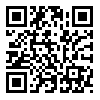Volume 1, Issue 5 (9-2017)
Iranian Journal of Educational Sociology 2017, 1(5): 1-11 |
Back to browse issues page
Download citation:
BibTeX | RIS | EndNote | Medlars | ProCite | Reference Manager | RefWorks
Send citation to:



BibTeX | RIS | EndNote | Medlars | ProCite | Reference Manager | RefWorks
Send citation to:
Namiranian F, Saif A, Ahadi H, Bahrami H. (2017). Comparison of effectiveness between smart and non-smart school regarding advancing and developing creativity amongst female 3rd grade high-school students of Tehran's District 8. Iranian Journal of Educational Sociology. 1(5), 1-11.
URL: http://iase-idje.ir/article-1-93-en.html
URL: http://iase-idje.ir/article-1-93-en.html
1- Department of Educational Psychology, Science and Research Branch, Islamic Azad University, Tehran, Iran
2- Professor Department of Educational Psychology, Science and Research Branch, Islamic Azad University, Tehran, Iran
2- Professor Department of Educational Psychology, Science and Research Branch, Islamic Azad University, Tehran, Iran
Abstract: (3149 Views)
Abstract
Purpose: Smart schools are schools equipped with electronic devices and advanced technology where innovative and new way of learning is taught by processing data and communication within the context of suitable curriculum. Methodology: The basis of current research has been designed to compare the effectiveness of developing creativity between two groups of female high schoolers attending smart schools versus female students attending non-smart schools. Furthermore, all the female subjects were attending 3rd grade which is equivalent of 11th grade students worldwide. The method utilized in this research is the comparison evaluation type. The statistical society of research subjects included female high schoolers of Tehran’s District 8 which encompasses of 10 public schools, 6 non-public or private schools, and one smart high school, with the total population of 1020 in which 300 students were selected by classified random method as the sample group of research. The mentioned random groups were selected from all above-mentioned schools accordingly to their populations. Initially, in order to assess the level of creativity, part A of the Torrance test was given to all subjects at the beginning of the school –year. Part B of the same test was given at the conclusion of the school-year. Finding: The yielding outcome of both tests were analyzed with T test, variance method, and Schaffer's follow-up test final and total assessment and evaluation of all the results a conclusion was reached indicating that the type of smart or non-smart schools had no effect in developing and advancing creativity. Discussion: However, the dual comparison between private and public schools demonstrated a real and factual significant differences with respect to developing creativity. This fact implies that private high schools are more equipped and suited to develop creativity.
Purpose: Smart schools are schools equipped with electronic devices and advanced technology where innovative and new way of learning is taught by processing data and communication within the context of suitable curriculum. Methodology: The basis of current research has been designed to compare the effectiveness of developing creativity between two groups of female high schoolers attending smart schools versus female students attending non-smart schools. Furthermore, all the female subjects were attending 3rd grade which is equivalent of 11th grade students worldwide. The method utilized in this research is the comparison evaluation type. The statistical society of research subjects included female high schoolers of Tehran’s District 8 which encompasses of 10 public schools, 6 non-public or private schools, and one smart high school, with the total population of 1020 in which 300 students were selected by classified random method as the sample group of research. The mentioned random groups were selected from all above-mentioned schools accordingly to their populations. Initially, in order to assess the level of creativity, part A of the Torrance test was given to all subjects at the beginning of the school –year. Part B of the same test was given at the conclusion of the school-year. Finding: The yielding outcome of both tests were analyzed with T test, variance method, and Schaffer's follow-up test final and total assessment and evaluation of all the results a conclusion was reached indicating that the type of smart or non-smart schools had no effect in developing and advancing creativity. Discussion: However, the dual comparison between private and public schools demonstrated a real and factual significant differences with respect to developing creativity. This fact implies that private high schools are more equipped and suited to develop creativity.
Keywords: Smart school, Information and Communication Technology, Teaching and Learning Process, Creativity
Type of Study: Research Article |
Subject:
Special
Received: 2017/04/24 | Accepted: 2017/06/25 | Published: 2017/08/23
Received: 2017/04/24 | Accepted: 2017/06/25 | Published: 2017/08/23
| Rights and permissions | |
 |
This work is licensed under a Creative Commons Attribution-NonCommercial 4.0 International License. |






.jpg)
